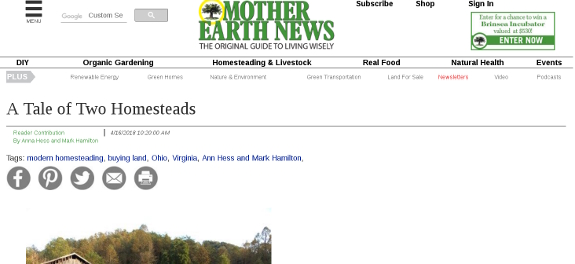
archives for 05/2018
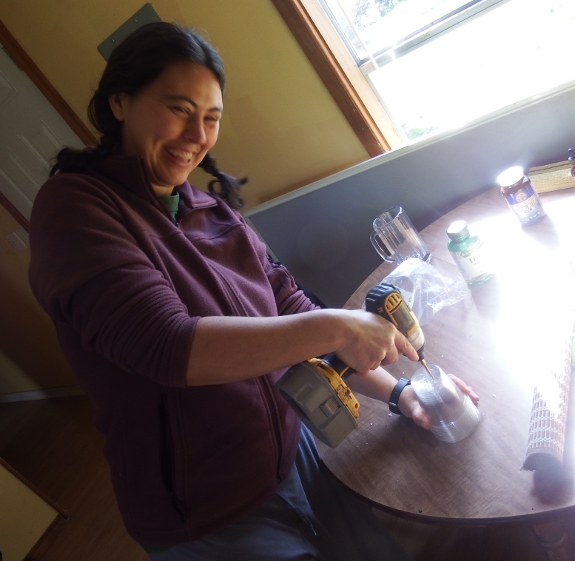
According to vendors at
the farmer's market, spring is running about three weeks late this
year. No wonder the first set of broccoli I set out is pouting. We are eating as much lettuce and
kale as we want, but it feels more like March than the first of May. My
solution? Start lots of plants indoors!
Of course, seedlings can
only hold in flats for so long. So I moved a bunch of them up to
plastic cups with holes drilled in the bottom. Nine-ounce cups are good
for medium growers for two to three weeks while sixteen-ounce cups will
hold fast growers for perhaps a month. I'm hopeful that before my
babies run out of room, the soil and air will have caught up to the
usual temperatures of spring.
The Winter snow plows did
some major damage to the street in front of our trailer.
Thank you to the hard working
crew that showed up this week to do repair work.
Seems like there should be a
more modern way of fixing pot holes?
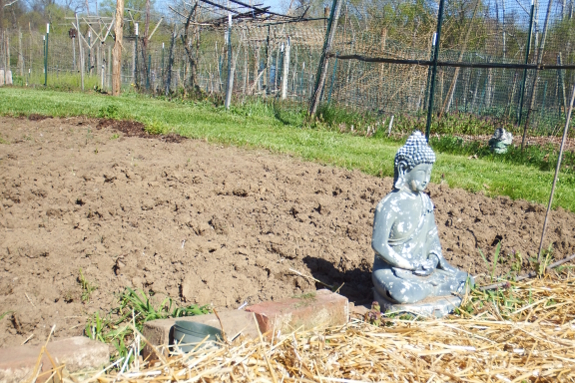
Athens contains multiple
community gardens. And even though I like building the soil in my own
space, I couldn't resist attending a community-gardener panel
discussion to see if the grass is greener on the other side of the
fence.
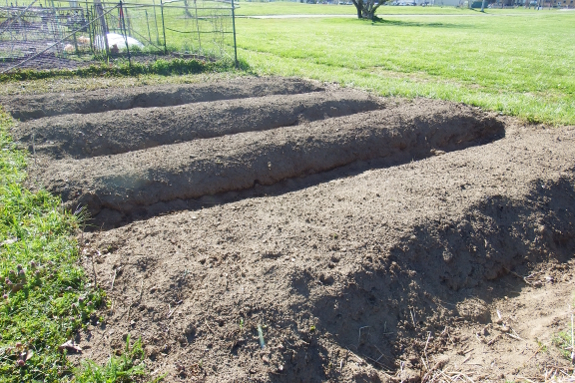
"Why did you join the
community gardener?" the moderator asked. The obvious answers were
space, sun, and soil --- some folks simply don't have appropriate
garden areas around their home. If they want to garden, it's going to
have to be somewhere else.
But the community aspect
of the shared garden space was also key to many of the gardeners'
decision to grow there. They enjoyed meeting other gardeners and
observing those folks' choices and crops. Even peer pressure was cited
as a positive --- a way to force yourself to get out there and weed!
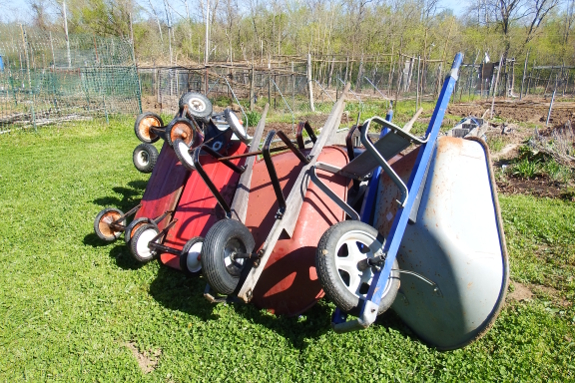
How about the negatives?
These were pretty much par for the course for any experienced gardener.
Harlequin bugs were apparently a huge problem in the surrounding plots
when one gardener got serious about the insects' favorite food ---
horseradish. Voles eat sweet potatoes and deer jump fences to nibble
everything. And, of course, there are always all those weeds. Sounds a
lot like my own gardening experiences.
Of course, there were
also a few site-specific challenges. Athens' community gardens are
close to the river and flooding can be a drag. Meanwhile, the plot in
Nelsonville is currently being moved to higher ground, not just because
of flooding but also because Johnsongrass took over so badly that it
wasn't worth growing there any longer.
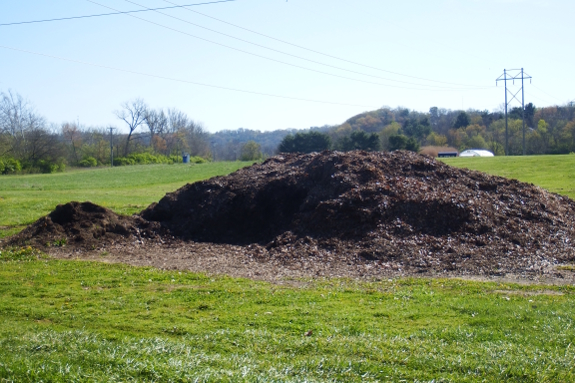
Like gardeners anywhere,
though, the panelists were eternally optimistic. And they even made me
jealous of one thing --- the huge piles of leaf mulch the city delivers
to each site in the fall. That was nearly enough to sign me up!
The nice guys from the local tree trimming service gave us a big pile of wood chips.
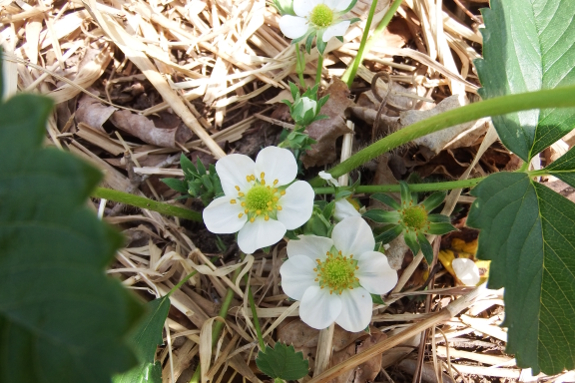
Both in the garden and
in the forest, this seems to be the week when life explodes. The
strawbery plants we brought from Virginia are in full bloom...
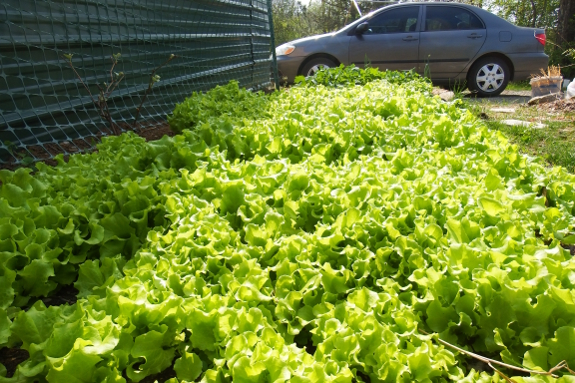
...our lettuce bed is so
bountiful I'm going to have to start giving some away...
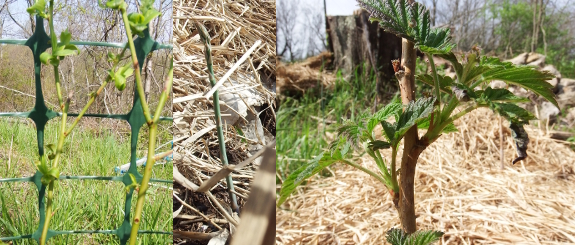
...and our new
perennials are beginning to show signs of life.
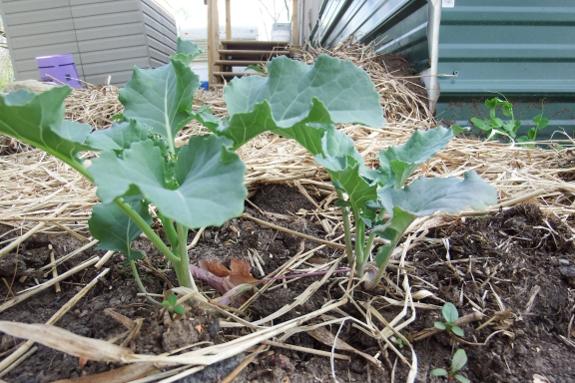
Of course, with any new
garden, there's always a learning curve. This picture illustrates two
changes I haven't quite worked into my garden routine yet --- cold soil
and high winds.
Up here on our ridgetop,
mulch blows around like crazy, which is why I ended up planting two
broccoli next door to each other. One was hidden under the straw!
And did you notice how
the plant on the right is half the size of the plant on the left? I
definitely set out my first round of broccoli too early --- the plants are still
there, growing slowly, but they were stunted by such a slow start on
life. Live and learn!
Anna brought me to the second
round of free archery at Burr Oak State Park.
It was a little windy but still lots of fun.
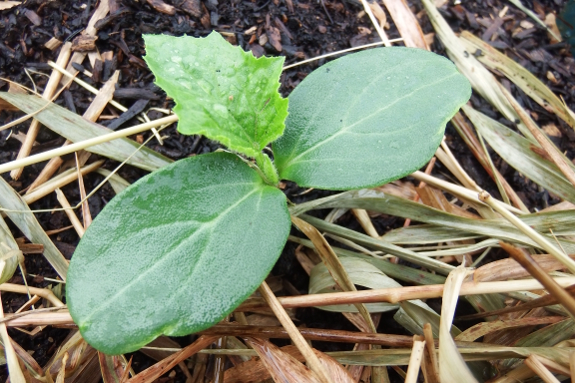
Did I learn from
planting my broccoli sets too early? Of course not.
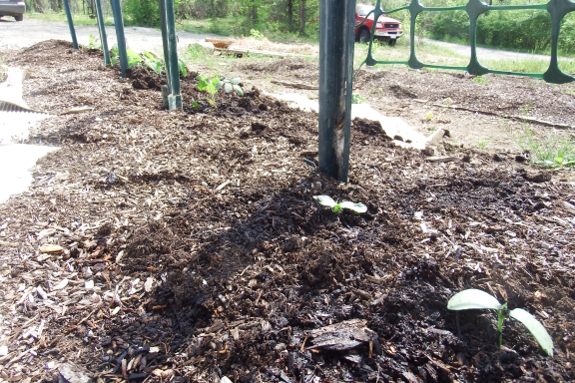
It's a gardener's
prerogative to push the envelope. So I went ahead and set out four
tomatoes, a row of cucumber seedlings, and a bunch of zinnia sets
nearly two weeks before the frost-free date.
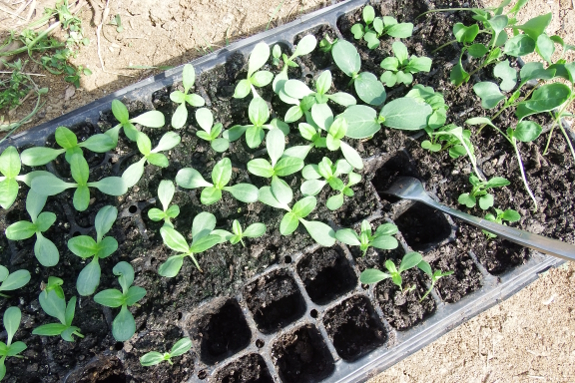
In my defense, the
forecast says it's going to stay warm. Maybe that's why I also
direct-seeded a bed of summer squash and one of beans? I'll either have
early crops or will be replanting everything within the next few weeks!
We started plotting out our
new garden fence perimeter this week.
There was a short debate
about making the fence underground to keep out critters that dig but we
decided deer was our biggest threat.
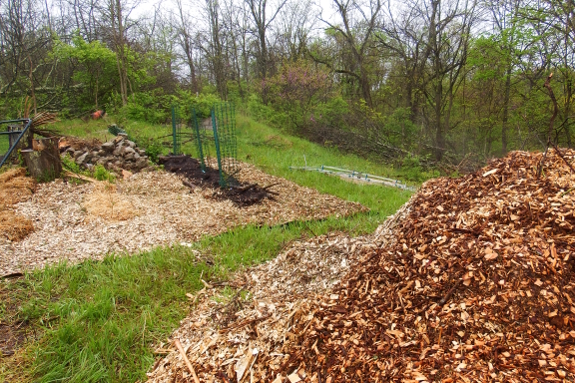
Mom: "What are you going
to do with your big pile
of wood chips?"
Anna: "Put them in the
garden."
Mom: "Won't they burn
the plants?"
Anna: "Not if I keep
them in the aisles!"
At our first homestead,
we chose to mow grassy pathways between permanent beds because it was
just too tough to haul in supplies. But here, cardboard and wood chips
appear to be copious and free for the asking. So I'm layering the
former then the latter between my beds to kill weeds and slowly build
soil. I'll be sure to keep you posted if the raw wood chips cause
problems placed so far from my plants.
Anna loves her new Corona Loppers.
Our old pair would allow for
knuckle busting if you were not careful.
The cutting blade is clearly
made from high grade metal.
A quality tool like this has
the potential to last multiple generations.
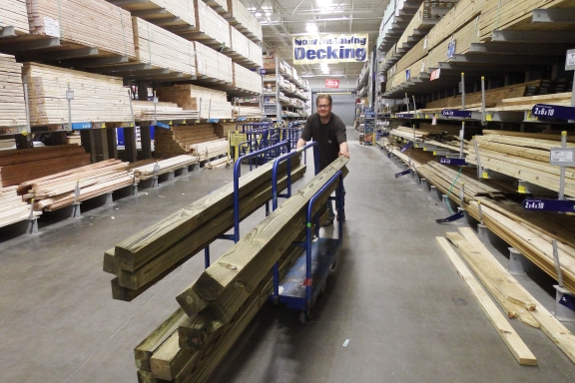
The photo in Mark's post
caught us laying out the eventual fence-post locations. We had some PVC
lying around, so we slipped lengths over rebar stakes to make it easy
to arrange the stakes in straight lines.
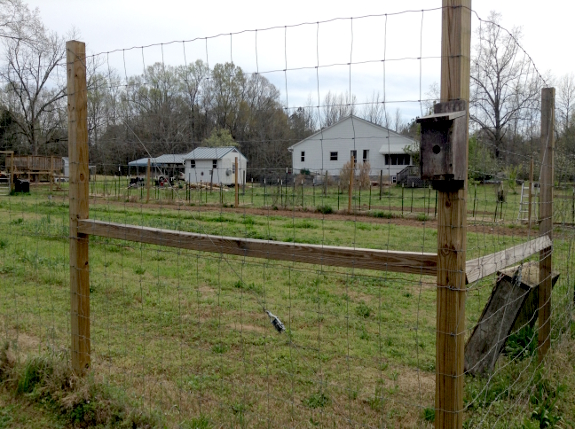
But neither stakes nor
PVC will be part of the final fence. Instead, we'll be attempting to
replicate my father's critter-proof
garden fence (a
section of which is shown above). To that end, we picked up twenty
ten-foot 4x4s (the main posts) and ten eight-foot 4x4s (to brace
corners and around the gate). Further supplies will include woven wire,
t-posts (for supplemental support between wooden posts), and
wire-tightening supplies. The birdhouse in Daddy's picture is, I'm
assuming, optional.
We are weighing the
advantages of expanding foam compared to concrete.
Do you have any experience
replacing concrete with Sika Fence Post Mix?
The price seems a little over
twice what concrete would cost.
The bag says a 33 ounce bag
can equal two 50 pound bags of concrete mix.
Last summer when Mark
and I decided to move away from our first homestead, many of you had
questions that could be summed up in a single word --- "Why?!"
I couldn't really answer
that question then. But time has given me understanding of what pushed
us to pick up stakes and create a new home further north.
If you're curious, you
can read that story in my
recent Mother Earth News guest post. Better that the explanation
come late rather than never, right?
Anna got a chance to test
drive a new double wheeled wheel barrow recently.
It holds more than our Kobalt
and the extra wheel gives you a lot more stability but is harder to
maneuver. In short Anna prefers a single wheeled wheel barrow unless we
were in a situation where we needed to push large loads long distances.
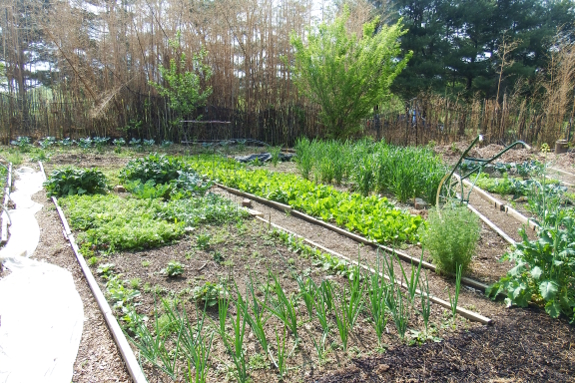
If you're ever in need
of a visual feast, I highly recommend dropping by Ohio University's
Learning Garden on West State Street. The soil is rich and well
watered, the beds perfectly weeded, and even cover crops can be sighted
amid the strawberries and leafy greens.
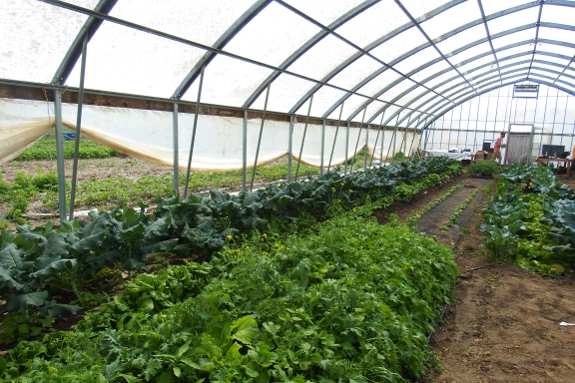
You can also buy produce
here dirt cheap --- Mark brought home a huge bag of various mustards
for a buck...which included a fifty-cent tip. I hear strawberries will
be ripe in the very near future.
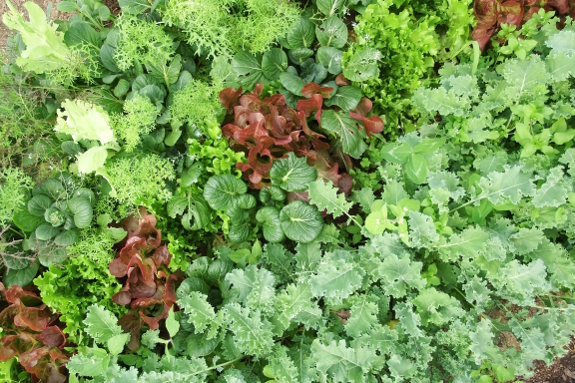
I have to admit I was
too engrossed in the beautiful colors and patterns to make useful
observations for the most part. I did note, however, how much happier
their broccoli are than mine. I was hoping that the current scraggly
showing was due to the weirdness of the spring this year, but it sounds
like it's due to the other variable changed between last spring and
this one --- handwatering instead of mechanized irrigation. After the
fence will come steady water!
We rented this two person
post hole auger to dig our garden fence post holes.
After doing a few holes we
decided to choose the half day rental which was enough time to get half
way done. It was very hard work and we discovered doing that many holes
in one morning was pretty close to our physical limit.
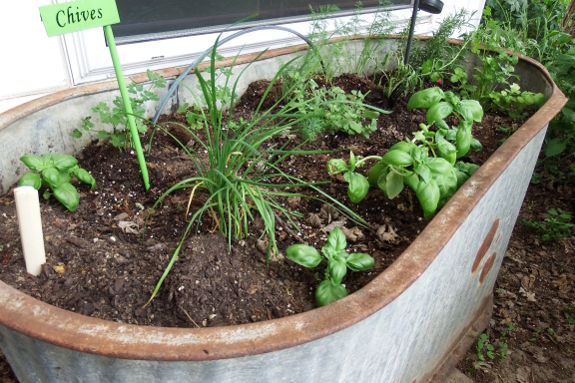
During a recent trip to
Mark's mom's house (which we still call "going to Ohio"...even though
we now live in Ohio), I stumbled across a couple of innovative
solutions for garden infrastructure that I thought you might enjoy.
First, the no-brainer --- an old stock tank with holes in the bottom
filled with compost to create an herb planter. Pretty and functional!
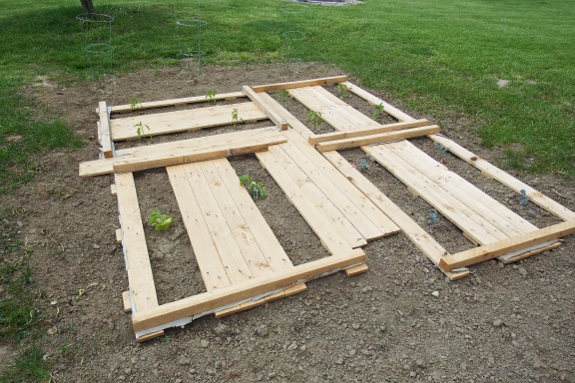
Next, I snuck over into her neighbor's yard to snap a shot of this interesting pallet mulch/pathway solution. I'll be curious to see how this does in a month or two --- I have a gut feeling it's going to be one of those solutions that looks better on paper than it works in reality. How do I know? I've tried dozens of those solutions myself!
Our second day of operating
the two person post hole digger went a lot better.
The first day we were using
an 8 inch bit that the guy at the rental store told us was a 6 inch
bit. There is a HUGE difference. We will never even look at an 8 inch
bit again.
The big lesson here is to
take a tape measure to the rental store and make sure you get the 6
inch bit. We got the second half of our post holes done in a fraction
of the time with much less effort. I guess you might need the 8 inch
bit if you were using 6x6 inch posts.
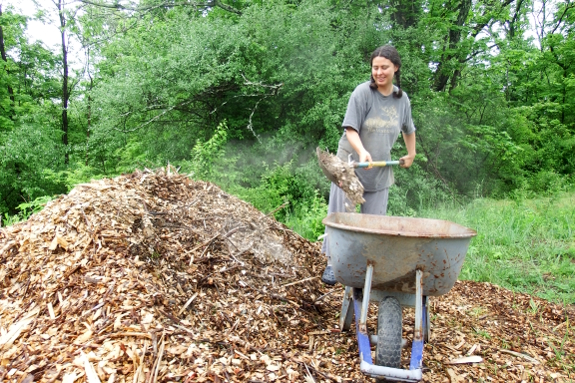
Anna: I've been putting
wood chips in the garden aisles and I'm running through the
pile fast. By this time next week, we're going to have to hunt down
more biomass!
Mark: That wood-chip
pile isn't half empty...it's half full.
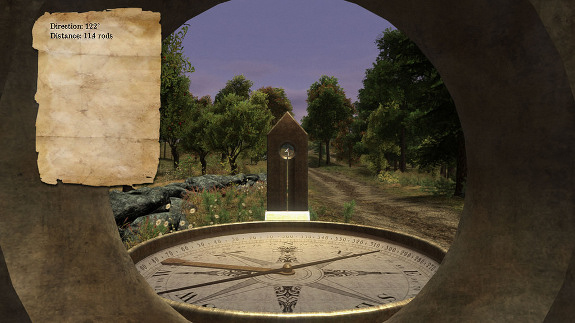
Walden,
the new game I blogged about last year is now on the Sony
Playstation 4.
It seems like a unique way to
experience the classic book.
We'd love to hear from any
readers that get a chance to play the Walden game.
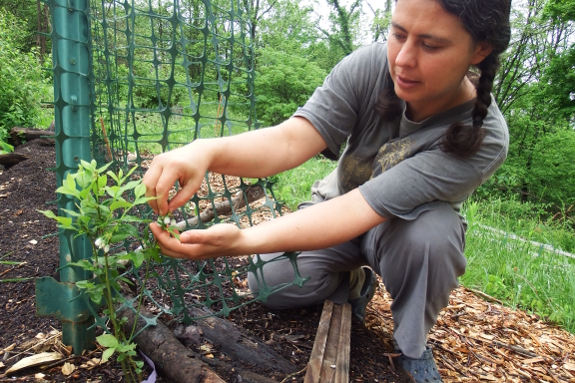
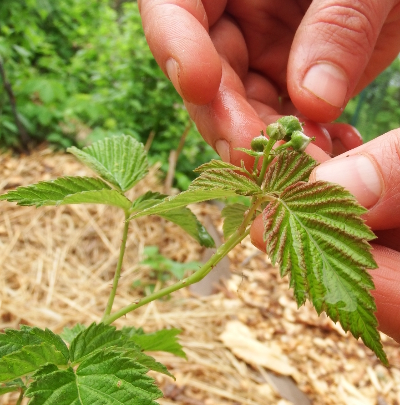 As painful as it is, year one in
a new garden is all about long-term thinking. So when both the
raspberries and the blueberries that we set out this spring developed
flower buds...I pinched them off.
As painful as it is, year one in
a new garden is all about long-term thinking. So when both the
raspberries and the blueberries that we set out this spring developed
flower buds...I pinched them off.The idea is that a new perennial is better off spending its limited energy on roots and leaves rather than on fruits. So no berries from that patch until next year.
The everbearing raspberries we planted last fall, in contrast, have enjoyed a bit more time to get their feet under them. So when they bloom --- probably for the fall crop --- we'll gladly let those flowers grow. Meanwhile last fall's strawberries are already ripening. In the new few days, I expect to pick our first Ohio-grown fruit!
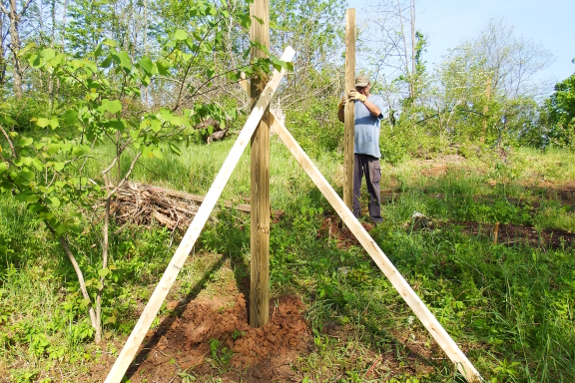
The Sika
foam seems adequate after doing a few test holes.
I'm still electing to use
concrete on the gate posts due to the extra tension.
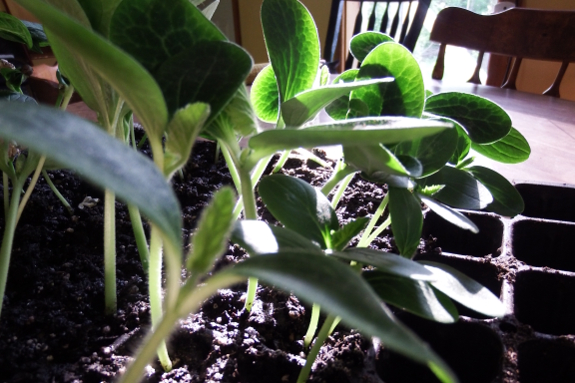
I was gone Friday
through Sunday at a writing retreat, and the garden exploded both
inside and out while I was away.
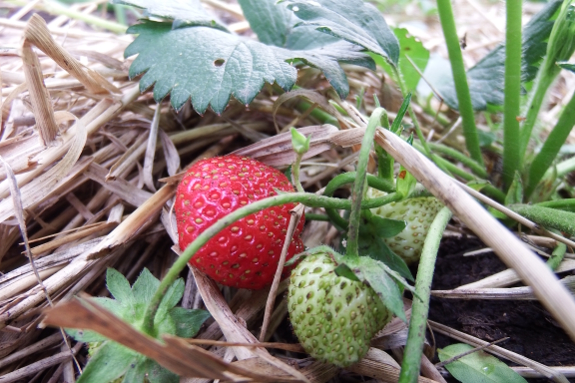
Ripening...
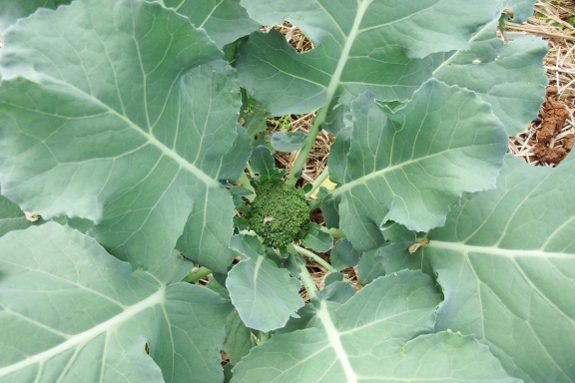
Heading...
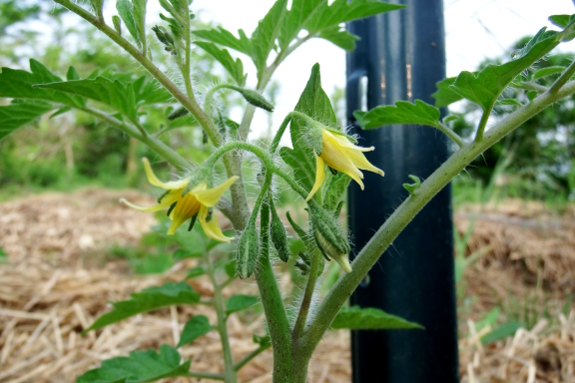
Flowering...
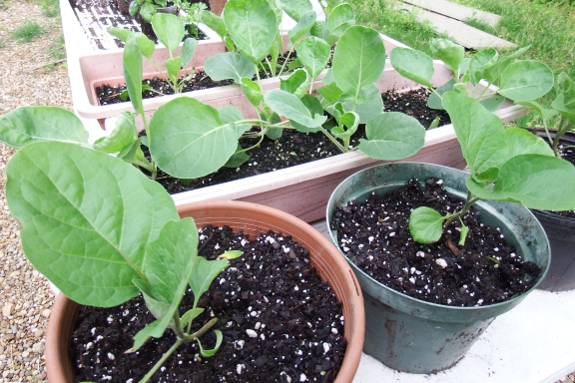
Which means it's time to
leave the keyboard, weed, and transplant!
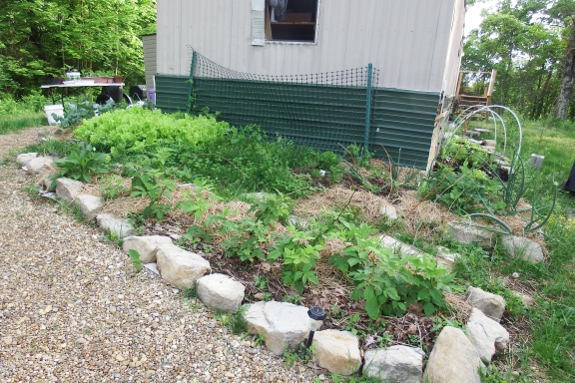
Planting greens so close to
our trailer has seemed to work at making them an unsafe choice for
local deer passing through our yard.
In the future we want to add
a large container in this area to catch water coming off the trailer
roof.
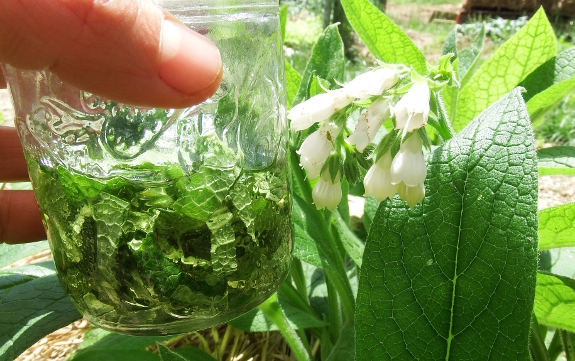
I like having comfrey
salve on hand for scratches, but I haven't made any since 2012.
Why? I made way too much my first time out of the gate! This time, I've
resolved to start with no more than a quarter cup of oil, which I hope
will last only a year or two instead rather than six.
Step 1: Cut tender young
comfrey leaves and pack into a jar. Pour olive oil over top of them and
let sit for two to six weeks.
Step 2: Check back in
June to see!

We saw the new Star Wars
movie on Friday and I liked it a lot.
If we had it to do over we
would watch the regular version over the 3D option.
There just weren't any moments
where I thought I was happy about choosing 3D.
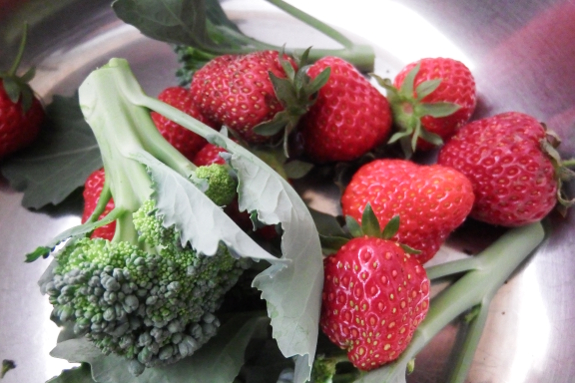
A new garden spot always
has new challenges. The first real issue popping up for us is compost
quality --- the topsoil/manure mixture 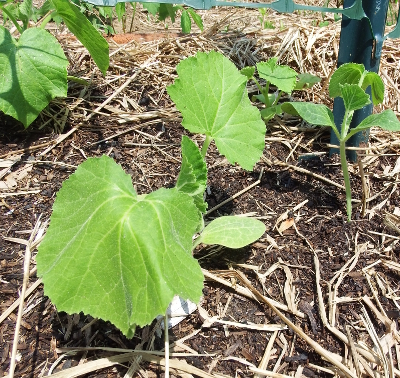 from
our neighbor was excellent (if a bit weedy), but the municipal compost
is clearly low on nitrogen. Slow growth and slightly yellow leaves on
heavy feeders while nitrogen-fixing beans grow just fine is a dead
giveaway.
from
our neighbor was excellent (if a bit weedy), but the municipal compost
is clearly low on nitrogen. Slow growth and slightly yellow leaves on
heavy feeders while nitrogen-fixing beans grow just fine is a dead
giveaway.
Luckily, low nitrogen is
an easy fix. This week, my goal is to follow up on a few leads for
other compost/manure sources suitable for topdressing. In the meantime,
we're gorging on lettuce, are picking the first small broccoli and a
smattering of strawberries, and are eying ripening peas.
It's been a long time since
we've tried growing eggplant.
We are leaving them in pots a
little longer so they will be strong enough to fight off their insect
predator.
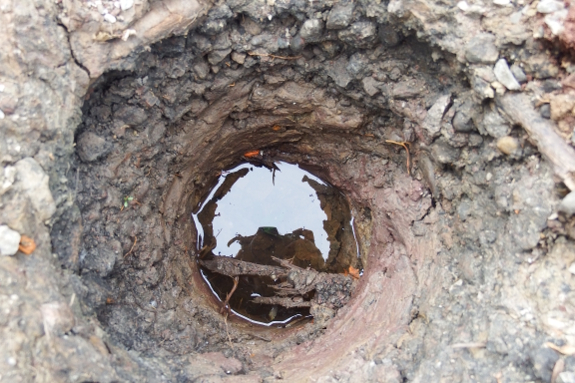
One downside of the non-concrete
fence-post mix is that it reacts violently with water. So the
manufacturers recommend either backfilling the hole or sopping up any
visible liquid before application.
How does that affect us?
Immediately after auger day, it set in to rain and continued until the
holes all filled up with groundwater. So far, the animals are mostly
leaving us alone, but we're hoping the weather will let us get more
posts in this week before deer find our crops.
In the meantime, if you
have four legs and are reading this post --- I hear the neighbors down
the road are planting strawberries. Go there!
After setting a few more
posts with foam
I decided to switch to concrete.
The problem I had was
weighing in my hands how much was only half to pour in the first hole
while it was beginning the expansion.
I kept putting in too much in
the first hole which would not leave enough for the second hole.
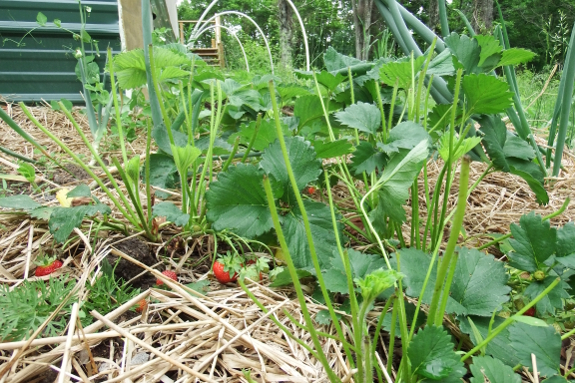
Or at least that's the
only reasoning I can come up with to explain months without deer
depredations then major munching the night after I made this post.
I remind myself that
year one in a new property is all about infrastructure-building and
learning the new lay of the land. But it still hurts when those darn
four-leggers nibble on my precious plants.
Want more in-depth information? Browse through our books.
Or explore more posts by date or by subject.
About us: Anna Hess and Mark Hamilton spent over a decade living self-sufficiently in the mountains of Virginia before moving north to start over from scratch in the foothills of Ohio. They've experimented with permaculture, no-till gardening, trailersteading, home-based microbusinesses and much more, writing about their adventures in both blogs and books.
